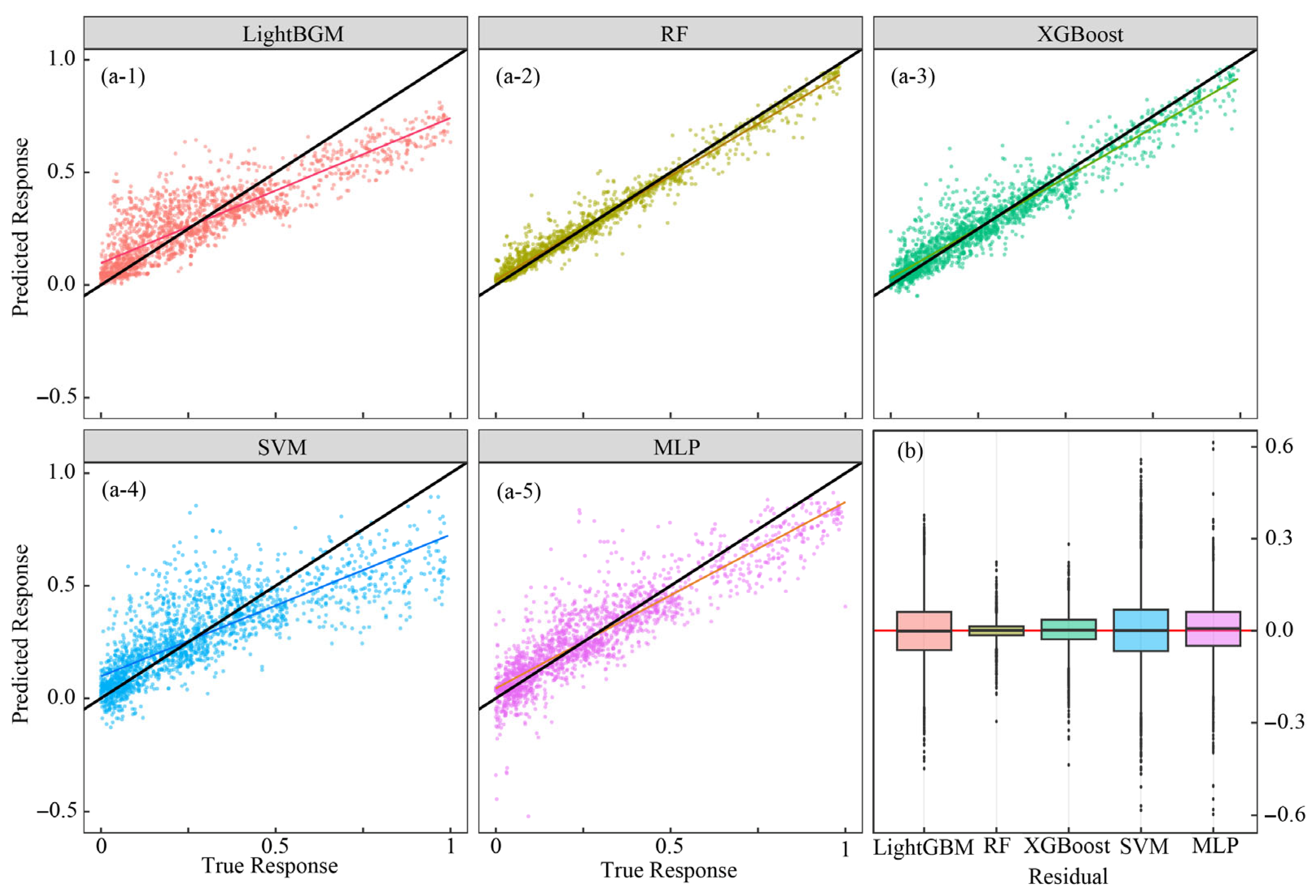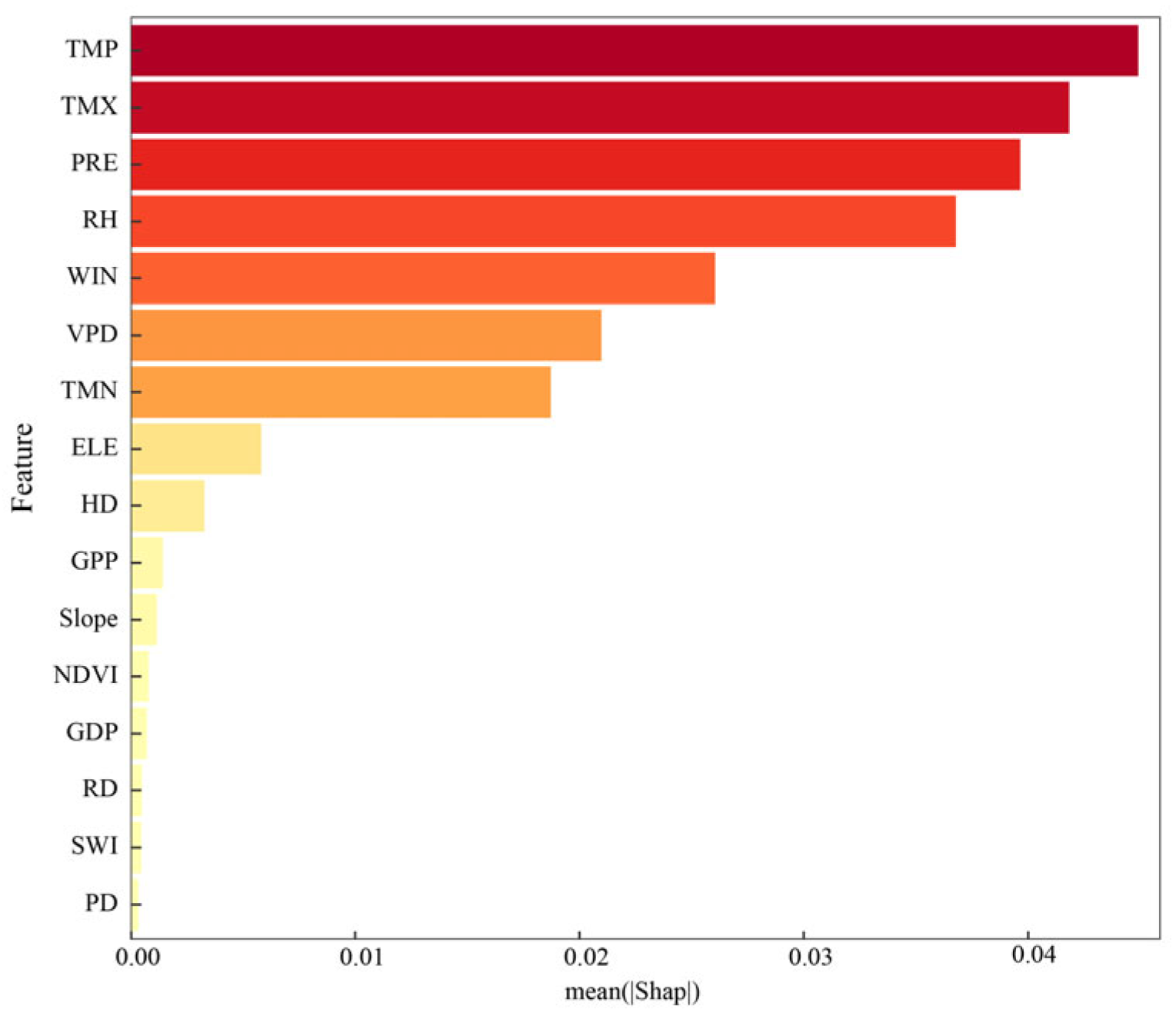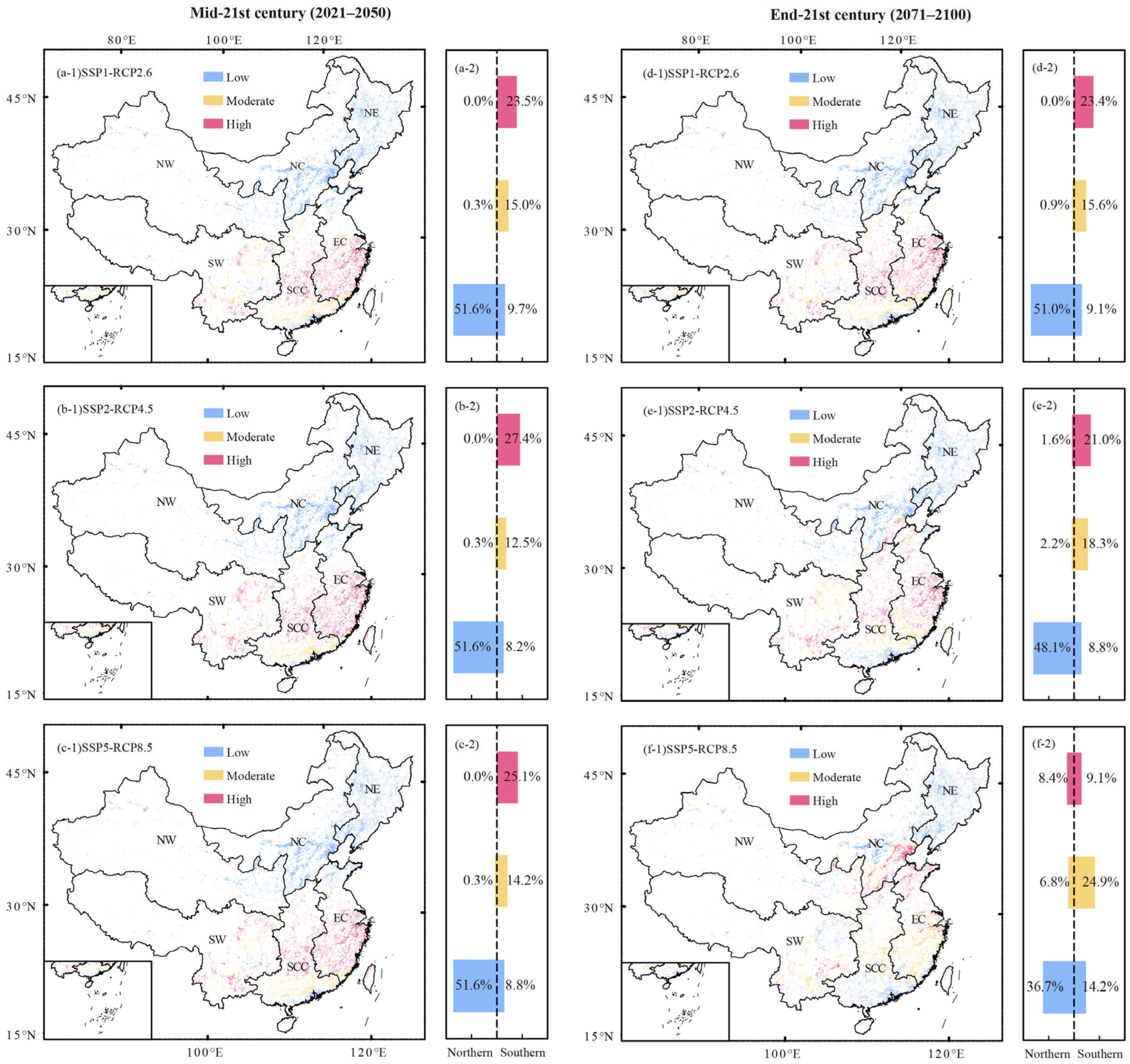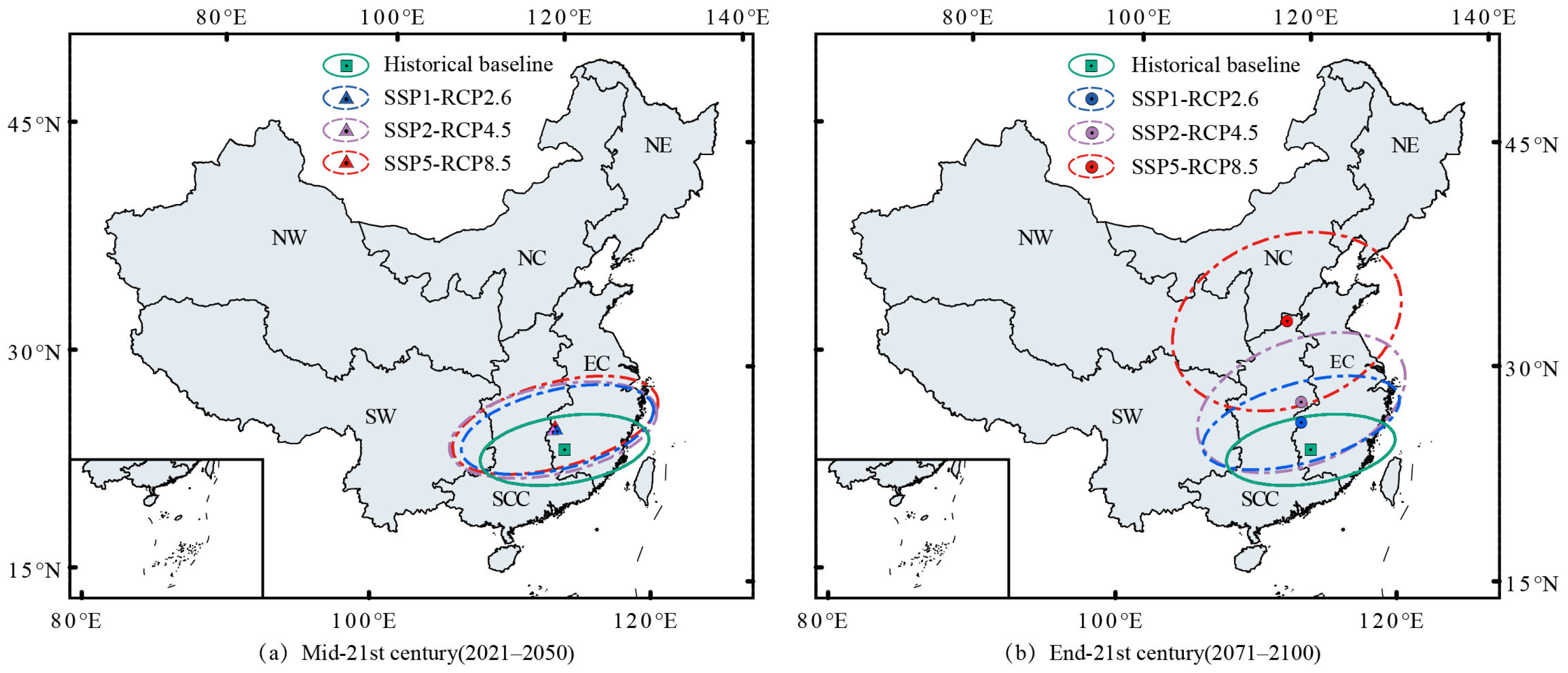Higher Emissions Scenarios Increase Wildland–Urban Interface Fire Hazard in China
Abstract
1. Introduction
2. Materials and Methods
2.1. Study Area
2.2. Data
- Meteorological data, including average air temperature (TMP), maximum air temperature (TMX), minimum air temperature (TMN), wind speed (WIN), relative humidity (RH), total precipitation (PRE), were obtained from national-level surface meteorological observation stations. These data were screened according to the proportion of missing elements (not higher than 5%) during the study period at each station. After screening, the remaining 2207 valid stations were corrected for anomalies and missing values and interpolated via multilinear regression analysis [34]. The vapor pressure deficit (VPD), which can be directly calculated from the temperature, indicates the extent to which the actual air is far from the water vapor saturation state, i.e., the degree of atmospheric aridity [35], and was obtained via empirical formulae [36].
- China’s digital elevation model (DEM) derived from Shuttle Radar Topography Mission (SRTM) data (http://srtm.csi.cgiar.org (accessed on 25 June 2025)). Using ArcGIS 10.8, we extracted elevation (ELE), slope, and aspect values. The aspect (, in degrees) was converted to a southwestness index (SWI) with a value between −1 and 1, indicating the degree to which the slope is oriented to the southwest, i.e., receives the maximum potential insolation [37,38].
- The MODIS satellite variables provided normalized vegetation index (NDVI) and gross primary productivity (GPP) data.
- Road distance (RD) and housing density (HD) originated from China’s National Geographic Information Resource Catalog System (http://www.webmap.cn (accessed on 25 June 2025)).
- The annual population density (PD) was derived from WorldPop (https://hub.worldpop.org/ (accessed on 25 June 2025)).
- Annual gross domestic product (GDP) data were sourced via Zenodo (https://www.zenodo.org/ (accessed on 25 June 2025)).
2.3. Hazard Assessment
2.4. Statistical Analysis
3. Results
3.1. Evaluation of Machine Learning Methods
3.2. WUI Fire Hazard Characteristics
3.3. Characteristics of High Hazard Area Deviation
4. Discussion
5. Conclusions
Funding
Institutional Review Board Statement
Informed Consent Statement
Data Availability Statement
Conflicts of Interest
References
- Guo, Y.; Wang, J.; Ge, Y.; Zhou, C. Global Expansion of Wildland-Urban Interface Intensifies Human Exposure to Wildfire Risk in the 21st Century. Sci. Adv. 2024, 10, eado9587. [Google Scholar] [CrossRef]
- Alcasena, F.J.; Salis, M.; Ager, A.A.; Castell, R.; Vega-García, C. Assessing Wildland Fire Risk Transmission to Communities in Northern Spain. Forests 2017, 8, 30. [Google Scholar] [CrossRef]
- Bowman, D.M.J.S.; Kolden, C.A.; Abatzoglou, J.T.; Johnston, F.H.; van der Werf, G.R.; Flannigan, M. Vegetation Fires in the Anthropocene. Nat. Rev. Earth Environ. 2020, 1, 500–515. [Google Scholar] [CrossRef]
- Schug, F.; Bar-Massada, A.; Carlson, A.R.; Cox, H.; Hawbaker, T.J.; Helmers, D.; Hostert, P.; Kaim, D.; Kasraee, N.K.; Martinuzzi, S.; et al. The global wildland–urban interface. Nature 2023, 621, 94–99. [Google Scholar] [CrossRef]
- Chen, B.; Wu, S.; Jin, Y.; Song, Y.; Wu, C.; Venevsky, S.; Xu, B.; Webster, C.; Gong, P. Wildfire Risk for Global Wildland–Urban Interface Areas. Nat. Sustain. 2024, 7, 474–484. [Google Scholar] [CrossRef]
- Godoy, M.M.; Martinuzzi, S.; Kramer, H.A.; Defossé, G.E.; Argañaraz, J.; Radeloff, V.C. Rapid WUI Growth in a Natural Amenity-Rich Region in Central-Western Patagonia, Argentina. Int. J. Wildland Fire 2019, 28, 473–484. [Google Scholar] [CrossRef]
- Chen, R.; Li, X.; Hu, Y.; Wen, C.; Peng, L. Road Extraction from Remote Sensing Images in Wildland–Urban Interface Areas. IEEE Geosci. Remote Sens. Lett. 2022, 19, 1–5. [Google Scholar] [CrossRef]
- Gong, D.; Sun, L.; Hu, T. Characterizing the Occurrence of Wildland-Urban Interface Fires and Their Important Factors in China. Ecol. Indic. 2024, 165, 112179. [Google Scholar] [CrossRef]
- Zong, X.; Tian, X.; Fang, L. Assessing Wildfire Risk and Mitigation Strategies in Qipanshan, China. Int. J. Disaster Risk Reduct. 2022, 80, 103237. [Google Scholar] [CrossRef]
- Fazel-Rastgar, F.; Sivakumar, V. Weather Pattern Associated with Climate Change During Canadian Arctic Wildfires: A Case Study in July 2019. Remote Sens. Appl. Soc. Environ. 2022, 25, 100698. [Google Scholar] [CrossRef]
- Kang, Y.; Jang, E.; Im, J.; Kwon, C.; Kim, S. Developing a New Hourly Forest Fire Risk Index Based on Catboost in South Korea. Appl. Sci. 2020, 10, 8213. [Google Scholar] [CrossRef]
- Lan, Z.; Su, Z.; Guo, M.; Alvarado, E.C.; Guo, F.; Hu, H.; Wang, G. Are Climate Factors Driving the Contemporary Wildfire Occurrence in China? Forests 2021, 12, 392. [Google Scholar] [CrossRef]
- Zhao, F.; Liu, Y. Atmospheric Circulation Patterns Associated with Wildfires in the Monsoon Regions of China. Geophys. Res. Lett. 2019, 46, 4873–4882. [Google Scholar] [CrossRef]
- Ellis, T.M.; Bowman, D.M.J.S.; Jain, P.; Flannigan, M.D.; Williamson, G.J. Global Increase in Wildfire Risk Due to Climate-Driven Declines in Fuel Moisture. Glob. Change Biol. 2022, 28, 1544–1559. [Google Scholar] [CrossRef]
- Vilar, L.; Herrera, S.; Tafur-García, E.; Yebra, M.; Martinez-Vega, J.; Echavarría, P.; Martín, M.P. Modelling Wildfire Occurrence at Regional Scale from Land Use/Cover and Climate Change Scenarios. Environ. Model. Softw. 2021, 145, 105200. [Google Scholar] [CrossRef]
- Bar-Massada, A.; Stewart, S.I.; Hammer, R.B.; Mockrin, M.H.; Radeloff, V.C. Using Structure Locations as a Basis for Mapping the Wildland-Urban Interface. J. Environ. Manag. 2013, 128, 540–547. [Google Scholar] [CrossRef] [PubMed]
- Johnston, L.M.; Flannigan, M.D. Mapping Canadian Wildland Fire Interface Areas. Int. J. Wildland Fire 2018, 27, 1–14. [Google Scholar] [CrossRef]
- Lampin-Maillet, C.; Jappiot, M.; Long, M.; Bouillon, C.; Morge, D.; Ferrier, J.-P. Mapping Wildland-Urban Interfaces at Large Scales Integrating Housing Density and Vegetation Aggregation for Fire Prevention in the South of France. J. Environ. Manag. 2010, 91, 732–741. [Google Scholar] [CrossRef] [PubMed]
- Radeloff, V.C.; Helmers, D.P.; Kramer, H.A.; Mockrin, M.H.; Alexandre, P.M.; Bar-Massada, A.; Butsic, V.; Hawbaker, T.J.; Martinuzzi, S.; Syphard, A.D.; et al. Rapid Growth of the US Wildland-Urban Interface Raises Wildfire Risk. Proc. Natl. Acad. Sci. USA 2018, 115, 3314–3319. [Google Scholar] [CrossRef]
- Theobald, D.M.; Romme, W.H. Expansion of the US Wildland–Urban Interface. Landsc. Urban Plan. 2007, 83, 340–354. [Google Scholar] [CrossRef]
- Herrero-Corral, G.; Jappiot, M.; Bouillon, C.; Long-Fournel, M. Application of a Geographical Assessment Method for the Characterization of Wildland–Urban Interfaces in the Context of Wildfire Prevention: A Case Study in Western Madrid. Appl. Geogr. 2012, 35, 60–70. [Google Scholar] [CrossRef]
- Rehm, R.G.; Mell, W. A Simple Model for Wind Effects of Burning Structures and Topography on Wildland–Urban Interface Surface-Fire Propagation. Int. J. Wildland Fire 2009, 18, 290–301. [Google Scholar] [CrossRef]
- Van Wagner, C.E. Structure of the Canadian Forest Fire Weather Index System; Canadian Forestry Service: Ottawa, ON, Canada, 1974; Volume 1333. [Google Scholar]
- Forkel, M.; Dorigo, W.; Lasslop, G.; Teubner, I.; Chuvieco, E.; Thonicke, K. A Data-Driven Approach to Identify Controls on Global Fire Activity from Satellite and Climate Observations (SOFIA V1). Geosci. Model Dev. 2017, 10, 4443–4476. [Google Scholar] [CrossRef]
- Jain, P.; Coogan, S.C.P.; Subramanian, S.G.; Crowley, M.; Taylor, S.; Flannigan, M.D. A Review of Machine Learning Applications in Wildfire Science and Management. Environ. Rev. 2020, 28, 478–505. [Google Scholar] [CrossRef]
- Camps-Valls, G.; Tuia, D.; Zhu, X.; Reichstein, M. Deep Learning for the Earth Sciences: A Comprehensive Approach to Remote Sensing, Climate Science, and Geosciences; Wiley: Hoboken, NJ, USA, 2021. [Google Scholar]
- Reichstein, M.; Camps-Valls, G.; Stevens, B.; Jung, M.; Denzler, J.; Carvalhais, N.; Prabhat. Deep Learning and Process Understanding for Data-Driven Earth System Science. Nature 2019, 566, 195–204. [Google Scholar] [CrossRef]
- Bento-Gonçalves, A.; Vieira, A. Wildfires in the Wildland-Urban Interface: Key Concepts and Evaluation Methodologies. Sci. Total Environ. 2020, 707, 135592. [Google Scholar] [CrossRef]
- Calkin, D.E.; Cohen, J.D.; Finney, M.A.; Thompson, M.P. How Risk Management Can Prevent Future Wildfire Disasters in the Wildland-Urban Interface. Proc. Natl. Acad. Sci. USA 2014, 111, 746–751. [Google Scholar] [CrossRef]
- Koksal, K.; McLennan, J.; Every, D.; Bearman, C. Australian Wildland-Urban Interface Householders’ Wildfire Safety Preparations: ‘Everyday Life’ Project Priorities and Perceptions of Wildfire Risk. Int. J. Disaster Risk Reduct. 2019, 33, 142–154. [Google Scholar] [CrossRef]
- Modugno, S.; Balzter, H.; Cole, B.; Borrelli, P. Mapping Regional Patterns of Large Forest Fires in Wildland–Urban Interface Areas in Europe. J. Environ. Manag. 2016, 172, 112–126. [Google Scholar] [CrossRef]
- Xue, J.; Li, K.; Li, H.; Wang, Y.; Guo, X.; Zhang, H.; Zhao, J.; Chen, H. A Novel Data Source for Human-Caused Wildfires in China: Extracting Information from Judgment Documents. Geomat. Nat. Hazards Risk 2024, 15, 2361132. [Google Scholar] [CrossRef]
- FAO. Guidelines on Fire Management in Temperate and Boreal Forests; Food and Agriculture Organization: Rome, Italy, 2002; Available online: https://openknowledge.fao.org/server/api/core/bitstreams/2b21e040-ea55-4894-92d3-d877631633a8/content (accessed on 1 July 2024).
- Tsinko, Y.; Bakhshaii, A.; Johnson, E.A.; Martin, Y.E. Comparisons of Fire Weather Indices Using Canadian Raw and Homogenized Weather Data. Agric. For. Meteorol. 2018, 262, 110–119. [Google Scholar] [CrossRef]
- Williams, A.P.; Abatzoglou, J.T.; Gershunov, A.; Guzman-Morales, J.; Bishop, D.A.; Balch, J.K.; Lettenmaier, D.P. Observed Impacts of Anthropogenic Climate Change on Wildfire in California. Earths Future 2019, 7, 892–910. [Google Scholar] [CrossRef]
- Allan, R.G.; Pereira, L.S.; Smith, M. Crop Evapotranspiration: Guidelines for Computing Crop Water Requirements. In FAO Irrigation and Drainage Paper 56; Food and Agriculture Organization: Rome, Italy, 1998. [Google Scholar]
- Khatchikian, C.; Sangermano, F.; Kendell, D.; Livdahl, T. Evaluation of Species Distribution Model Algorithms for Fine-Scale Container-Breeding Mosquito Risk Prediction. Med. Vet. Entomol. 2011, 25, 268–275. [Google Scholar] [CrossRef] [PubMed]
- Trang, P.T.; Andrew, M.E.; Chu, T.; Enright, N.J. Forest Fire and Its Key Drivers in the Tropical Forests of Northern Vietnam. Int. J. Wildland Fire 2022, 31, 213–229. [Google Scholar] [CrossRef]
- Su, B.; Huang, J.; Mondal, S.K.; Zhai, J.; Wang, Y.; Wen, S.; Gao, M.; Lv, Y.; Jiang, S.; Jiang, T.; et al. Insight from CMIP6 SSP-RCP Scenarios for Future Drought Characteristics in China. Atmos. Res. 2021, 250, 105375. [Google Scholar] [CrossRef]
- You, Q.; Cai, Z.; Wu, F.; Jiang, Z.; Pepin, N.; Shen, S.S.P. Temperature Dataset of CMIP6 Models over China: Evaluation, Trend and Uncertainty. Clim. Dyn. 2021, 57, 17–35. [Google Scholar] [CrossRef]
- Anav, A.; Friedlingstein, P.; Kidston, M.; Bopp, L.; Ciais, P.; Cox, P.; Jones, C.; Jung, M.; Myneni, R.; Zhu, Z. Evaluating the Land and Ocean Components of the Global Carbon Cycle in the CMIP5 Earth System Models. J. Clim. 2013, 26, 6801–6843. [Google Scholar] [CrossRef]
- Zhu, Z.; Piao, S.; Myneni, R.B.; Huang, M.; Zeng, Z.; Caadell, J.G.; Ciais, P.; Sitch, S.; Friedlingstein, P.; Arneth, A.; et al. Greening of the Earth and its drivers. Nat. Clim. Change 2016, 6, 791–795. [Google Scholar] [CrossRef]
- Mao, J.; Ribes, A.; Yan, B.; Shi, X.; Thornton, P.E.; Séférian, R.; Ciais, P.; Myneni, R.B.; Douville, H.; Piao, S.; et al. Human-Induced Greening of the Northern Extratropical Land Surface. Nat. Clim. Change 2016, 6, 959–963. [Google Scholar] [CrossRef]
- Xu, C.; McDowell, N.G.; Fisher, R.A.; Wei, L.; Sevanto, S.; Christoffersen, B.O.; Weng, E.; Middleton, R.S. Increasing Impacts of Extreme Droughts on Vegetation Productivity Under Climate Change. Nat. Clim. Change 2019, 9, 948–953. [Google Scholar] [CrossRef]
- Sillmann, J.; Kharin, V.V.; Zhang, X.; Zwiers, F.W.; Bronaugh, D. Climate Extremes Indices in the CMIP5 Multimodel Ensemble: Part 1. Model Evaluation in the Present Climate. J. Geophys. Res. Atmos. 2013, 118, 1716–1733. [Google Scholar] [CrossRef]
- Yang, M.; Xiao, T.; Li, Y.; Hu, T. Evaluation and Projection of Climate Change in Southwest China Using CMIP6 Models. Plateau Meteorol. 2022, 41, 1557–1571. [Google Scholar] [CrossRef]
- Rhymee, H.; Shams, S.; Ratnayake, U.; Rahman, E.K.A. Comparing Statistical Downscaling and Arithmetic Mean in Simulating CMIP6 Multi-Model Ensemble over Brunei. Hydrology 2022, 9, 161. [Google Scholar] [CrossRef]
- Kondylatos, S.; Prapas, I.; Ronco, M.; Papoutsis, I.; Camps-Valls, G.; Piles, M.; Fernández-Torres, M.-Á.; Carvalhais, N. Wildfire Danger Prediction and Understanding with Deep Learning. Geophys. Res. Lett. 2022, 49, e2022GL099368. [Google Scholar] [CrossRef]
- Thompson, M.P.; Zimmerman, T.; Mindar, D.; Taber, M. Risk Terminology Primer: Basic Principles and a Glossary for the Wildland Fire Management Community; Rocky Mountain Research Station: Fort Collins, CO, USA, 2016. [Google Scholar]
- Pettinari, M.L.; Chuvieco, E. Fire Danger Observed from Space. Surv. Geophys. 2020, 41, 1437–1459. [Google Scholar] [CrossRef]
- Chen, R.; He, B.; Li, Y.; Fan, C.; Yin, J.; Zhang, H.; Zhang, Y. Estimation of Potential Wildfire Behavior Characteristics to Assess Wildfire Danger in Southwest China Using Deep Learning Schemes. J. Environ. Manag. 2024, 351, 120005. [Google Scholar] [CrossRef]
- Koutsias, N.; Balatsos, P.; Kalabokidis, K. Fire Occurrence Zones: Kernel Density Estimation of Historical Wildfire Ignitions at the National Level, Greece. J. Maps 2014, 10, 630–639. [Google Scholar] [CrossRef]
- Wu, L.; Zhou, H.; Ma, X.; Fan, J.; Zhang, F. Daily Reference Evapotranspiration Prediction Based on Hybridized Extreme Learning Machine Model with Bio-Inspired Optimization Algorithms: Application in Contrasting Climates of China. J. Hydrol. 2019, 577, 123960. [Google Scholar] [CrossRef]
- Parsa, A.B.; Movahedi, A.; Taghipour, H.; Derrible, S.; Mohammadian, A. Toward Safer Highways, Application of XGBoost and SHAP for Real-Time Accident Detection and Feature Analysis. Accid. Anal. Prev. 2020, 136, 105405. [Google Scholar] [CrossRef]
- Lorenzoni, I.; Pidgeon, N.F.; O’Connor, R.E. Dangerous Climate Change: The Role for Risk Research. Risk Anal. 2005, 25, 1387–1398. [Google Scholar] [CrossRef]
- Zong, X.; Tian, X.; Wang, X. The Role of Fuel Treatments in Mitigating Wildfire Risk. Landsc. Urban Plan. 2024, 242, 104957. [Google Scholar] [CrossRef]
- Duman, Z.; Mao, X.; Cai, B.; Zhang, Q.; Chen, Y.; Gao, Y.; Guo, Z. Exploring the Spatiotemporal Pattern Evolution of Carbon Emissions and Air Pollution in Chinese Cities. J. Environ. Manag. 2023, 345, 118870. [Google Scholar] [CrossRef]
- Guo, M.; Yao, Q.; Suo, H.; Xu, X.; Li, J.; He, H.; Yin, S.; Li, J. The Importance Degree of Weather Elements in Driving Wildfire Occurrence in Mainland China. Ecol. Indic. 2023, 148, 110152. [Google Scholar] [CrossRef]
- Ying, L.; Cheng, H.; Shen, Z.; Guan, P.; Luo, C.; Peng, X. Relative Humidity and Agricultural Activities Dominate Wildfire Ignitions in Yunnan, Southwest China: Patterns, Thresholds, and Implications. Agric. For. Meteorol. 2021, 307, 108540. [Google Scholar] [CrossRef]
- Shmuel, A.; Lazebnik, T.; Heifetz, E.; Glickman, O.; Price, C. Fire weather indices tailored to regional patterns outperform global models. Npj Nat. Hazards 2025, 2, 74. [Google Scholar] [CrossRef]
- Tian, X.; Zhao, F.; Shu, L.; Wang, M. Changes in forest fire danger for south-western China in the 21st century. Int. J. Wildland Fire 2014, 23, 185–195. [Google Scholar] [CrossRef]
- Tian, X.; McRae, D.J.; Jizhong, J.; Shu, L.; Zhao, F.; Wang, M. Changes of Forest Fire Danger and the Evaluation of the FWISystem Application in the Daxing’anling Region. Sci. Silvae Sin. 2010, 46, 127–132. [Google Scholar] [CrossRef]
- Yang, M.; Yao, Q.; Fang, K.; Dong, Z. Applications of Canadian Forest Fire Weather Index System in the World and China. J. Subtrop. Resour. Environ. 2021, 16, 48–54. [Google Scholar] [CrossRef]
- Belgiu, M.; Drăguţ, L. Random Forest in Remote Sensing: A Review of Applications and Future Directions. ISPRS J. Photogramm. Remote Sens. 2016, 114, 24–31. [Google Scholar] [CrossRef]
- Breiman, L. Random Forests. Mach. Learn. 2001, 45, 5–32. [Google Scholar] [CrossRef]
- Mellor, A.; Boukir, S.; Haywood, A.; Jones, S. Exploring Issues of Training Data Imbalance and Mislabelling on Random Forest Performance for Large Area Land Cover Classification Using the Ensemble Margin. ISPRS J. Photogramm. Remote Sens. 2015, 105, 155–168. [Google Scholar] [CrossRef]
- Aldersley, A.; Murray, S.J.; Cornell, S.E. Global and Regional Analysis of Climate and Human Drivers of Wildfire. Sci. Total Environ. 2011, 409, 3472–3481. [Google Scholar] [CrossRef]
- Collins, L.; Griffioen, P.; Newell, G.; Mellor, A. The Utility of Random Forests for Wildfire Severity Mapping. Remote Sens. Environ. 2018, 216, 374–384. [Google Scholar] [CrossRef]
- Oliveira, S.; Zêzere, J.L.; Queirós, M.; Pereira, J.M. Assessing the Social Context of Wildfire-Affected Areas. The Case of Mainland Portugal. Appl. Geogr. 2017, 88, 104–117. [Google Scholar] [CrossRef]
- Andela, N.; Morton, D.C.; Giglio, L.; Chen, Y.; van der Werf, G.R.; Kasibhatla, P.S.; DeFries, R.S.; Collatz, G.J.; Hantson, S.; Kloster, S.; et al. A Human-Driven Decline in Global Burned Area. Science 2017, 356, 1356–1362. [Google Scholar] [CrossRef] [PubMed]
- Chen, B.; Jin, Y.; Scaduto, E.; Moritz, M.A.; Goulden, M.L.; Randerson, J.T. Climate, Fuel, and Land Use Shaped the Spatial Pattern of Wildfire in California’s Sierra Nevada. J. Geophys. Res. Biogeosci. 2021, 126, e2020JG005786. [Google Scholar] [CrossRef]
- Holden, Z.A.; Swanson, A.; Luce, C.H.; Jolly, W.M.; Maneta, M.; Oyler, J.W.; Warren, D.A.; Parsons, R.; Affleck, D. Decreasing Fire Season Precipitation Increased Recent Western US Forest Wildfire Activity. Proc. Natl. Acad. Sci. USA 2018, 115, E8349–E8357. [Google Scholar] [CrossRef]
- Richardson, D.; Black, A.S.; Irving, D.; Matear, R.J.; Monselesan, D.P.; Risbey, J.S.; Squire, D.T.; Tozer, C.R. Global Increase in Wildfire Potential from Compound Fire Weather and Drought. npj Clim. Atmos. Sci. 2022, 5, 23. [Google Scholar] [CrossRef]
- Zong, X.; Tian, X.; Liu, J. A Fire Regime Zoning System for China. Front. For. Glob. Change 2021, 4, 717499. [Google Scholar] [CrossRef]
- Su, H.; Yu, Y.; Guo, W.; Mao, J. Convective potential and fuel availability complement near-surface weather in regulating global wildfire activity. Sci. Adv. 2025, 11, eadp7765. [Google Scholar] [CrossRef]
- Cawson, J.G.; Collins, L.; Parks, S.A.; Nolan, R.H.; Penman, T.D. Atmospheric dryness removes barriers to the development of large forest fires. Agric. For. Meteorol. 2024, 350, 109990. [Google Scholar] [CrossRef]
- Tian, X.; Dai, X.; Wang, M.; Zhao, F.; Shu, L. Forest Fire Risk Assessment for China Under Different Climate Scenarios. Chin. J. Appl. Ecol. 2016, 27, 769–776. [Google Scholar] [CrossRef]
- Yang, X.; Zhou, B.; Xu, Y.; Han, Z. CMIP6 Evaluation and Projection of Temperature and Precipitation over China. Adv. Atmos. Sci. 2021, 38, 817–830. [Google Scholar] [CrossRef]
- Chawla, I.; Mujumdar, P.P. Isolating the impacts of land use and climate change on streamflow. Hydrol. Earth Syst. Sci. 2015, 19, 3633–3651. [Google Scholar] [CrossRef]
- Zhang, J.; Wu, T.; Li, L.; Furtado, K.; Xin, X.; Xie, C.; Zheng, M.; Zhao, H.; Zhou, Y. Constraint on regional land surface air temperature projections in CMIP6 multi-model ensemble. NPJ Clim. Atmos. Sci. 2023, 6, 85. [Google Scholar] [CrossRef]
- Yu, H.W.; Wang, S.Y.S.; Liu, W.Y. Estimating Wildfire Potential in Taiwan Under Different Climate Change Scenarios. Clim. Change 2024, 177, 13. [Google Scholar] [CrossRef]







| Mold | RMSE | MAE | R2 | CCC |
|---|---|---|---|---|
| SVM | 0.1450 | 0.1020 | 0.634 | 0.774 |
| RF | 0.0405 | 0.0254 | 0.974 | 0.985 |
| XGBoost | 0.0662 | 0.0463 | 0.925 | 0.959 |
| LightGBM | 0.1220 | 0.0901 | 0.763 | 0.835 |
| MLP | 0.1050 | 0.0764 | 0.812 | 0.898 |
Disclaimer/Publisher’s Note: The statements, opinions and data contained in all publications are solely those of the individual author(s) and contributor(s) and not of MDPI and/or the editor(s). MDPI and/or the editor(s) disclaim responsibility for any injury to people or property resulting from any ideas, methods, instructions or products referred to in the content. |
© 2025 by the author. Licensee MDPI, Basel, Switzerland. This article is an open access article distributed under the terms and conditions of the Creative Commons Attribution (CC BY) license (https://creativecommons.org/licenses/by/4.0/).
Share and Cite
Gong, D. Higher Emissions Scenarios Increase Wildland–Urban Interface Fire Hazard in China. Sustainability 2025, 17, 7409. https://doi.org/10.3390/su17167409
Gong D. Higher Emissions Scenarios Increase Wildland–Urban Interface Fire Hazard in China. Sustainability. 2025; 17(16):7409. https://doi.org/10.3390/su17167409
Chicago/Turabian StyleGong, Dapeng. 2025. "Higher Emissions Scenarios Increase Wildland–Urban Interface Fire Hazard in China" Sustainability 17, no. 16: 7409. https://doi.org/10.3390/su17167409
APA StyleGong, D. (2025). Higher Emissions Scenarios Increase Wildland–Urban Interface Fire Hazard in China. Sustainability, 17(16), 7409. https://doi.org/10.3390/su17167409






